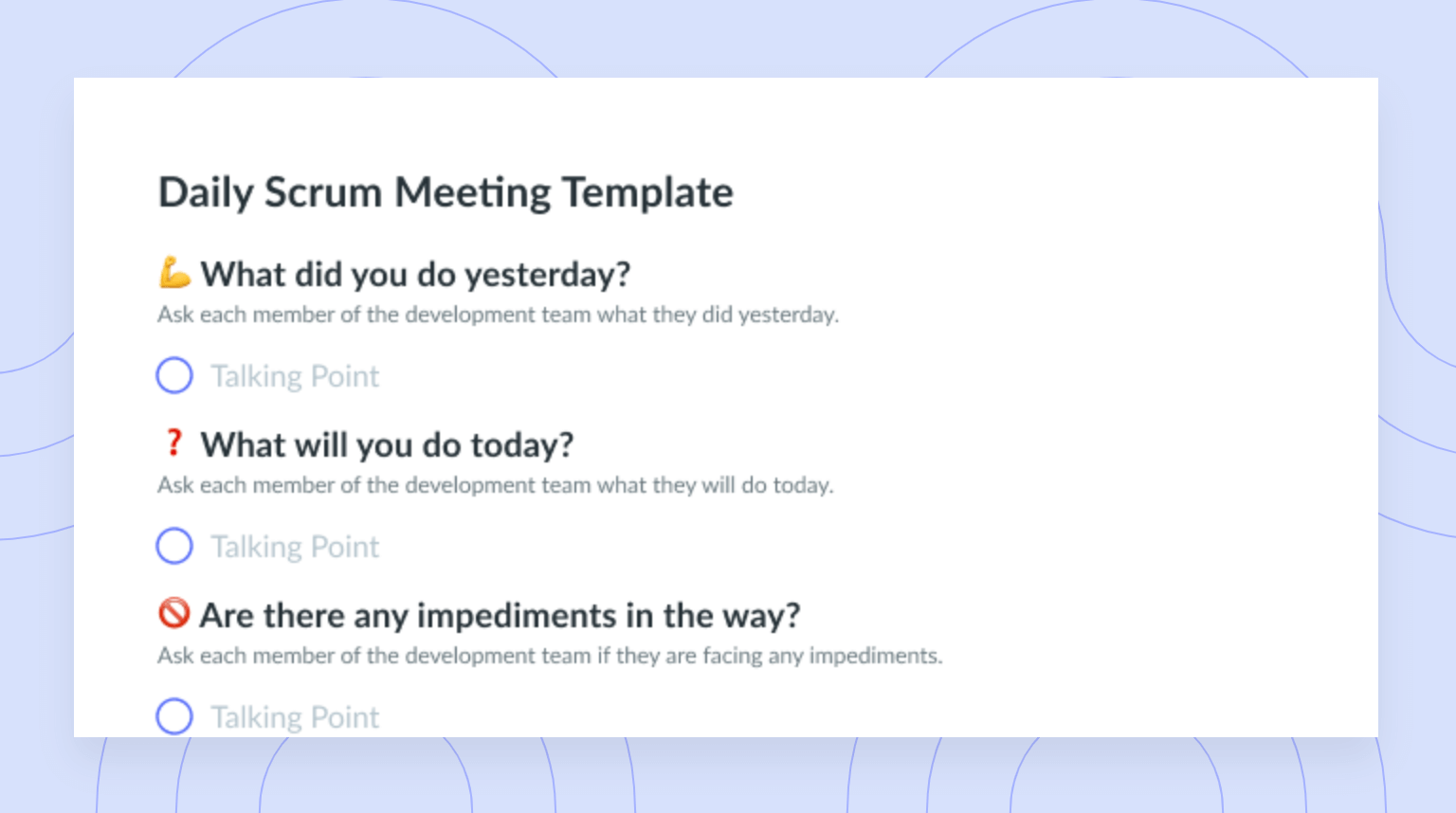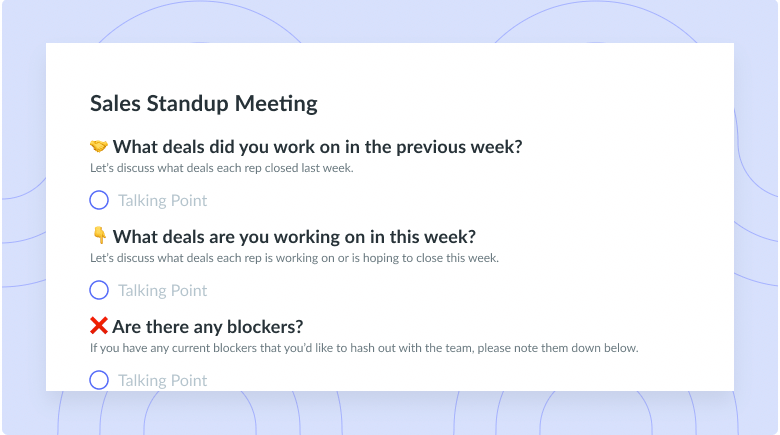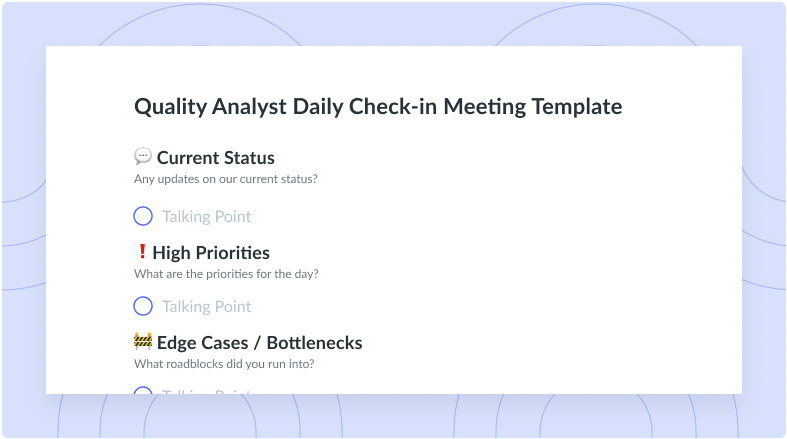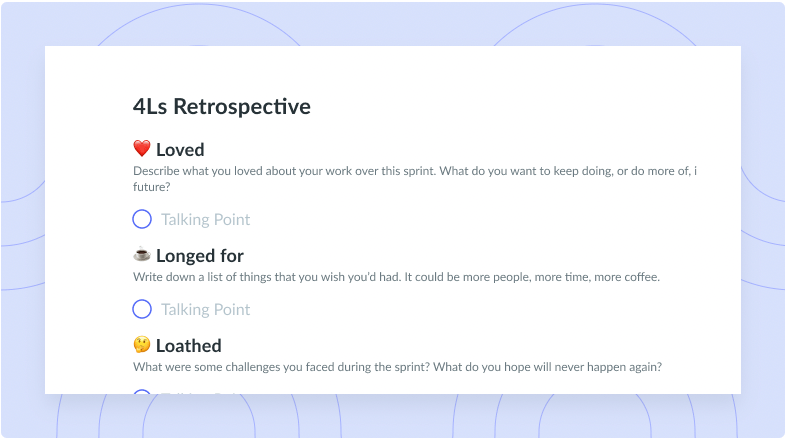Daily Scrum: 3 Questions + How to Maximize Them
Learn all about daily scrums, including 3 daily scrum questions that can make for an impactful 15 minutes in your team’s workday here!
As funny of a word as it might sound, Scrum is key for teams that work on both small and large projects. One of the simplest parts of the Scrum framework is the Scrum meeting. Below, learn more about Scrum meetings and the three daily Scrum questions that can help you make the most of these short huddles.
- What is Scrum?
- What is the daily Scrum meeting?
- 4 advantages of the daily Scrum
- Breaking down the three daily Scrum questions
- The purpose of the daily Scrum
- Daily Scrum meeting best practices
What is Scrum?
Scrum is an agile project management methodology that involves working on a project in small pieces. In Scrum, these tiny pieces are called sprints.
Scrum was originally a rugby term. In rugby, “scrum” describes when team members try to move the ball down the field. The same concept applies to project management when an Agile team works to efficiently move a project forward.

Great Scrum meetings are just the start!
Level up your meeting habits to boost engagement and productivity with a collaborative meeting agenda. Try a tool like Fellow!

What is the daily Scrum meeting?
During the daily Scrum meeting, team members share what they’ve done since the last meeting and what they’ll work on before the next one. Team members will also share any challenges and potential solutions.
Daily scrum meetings last about 15 minutes, and they typically happen at the start of each working day. Holding them as standup meetings can help your team stick to the time limit.
4 advantages of the daily Scrum
Daily Scrum meetings bring team members together to keep everyone working in sync. Below are four benefits of holding a team-focused Scrum meeting at the start of each workday.
- Increases motivation. During Scrum meetings, team members can see everyone’s progress toward the team’s sprint goals. This can set a work pace for your Scrum team and encourage everyone to play their part.
- Encourages collaboration. Scrum meetings bring everyone together to move a project forward. Team members can share any concerns or challenges they’re facing with their work. From there, the rest of the team can pitch in to find solutions that help both that team member and everyone else in the room.
- Keeps team members focused on the end goal. With all the moving parts involved in a project, it can be easy to get lost in the details. And given how much work team members handle in a day, they could accidentally lose sight of the bigger picture. During Scrum meetings, your team can highlight what it needs to focus on and make sure everyone is moving toward the same finish line.
- Tracks progress. As your team shares updates about their work from the previous day, you can see exactly how well your team is progressing. You’ll know about any lingering tasks and any objectives your team has checked off its list. You’ll also know whether you’ll need to spend more time on sprint planning to help keep the team on track.
Breaking down the three daily Scrum questions
To help you host the most effective daily standups, below are three questions to ask during each meeting.
- What did you work on and achieve yesterday?
- What will you work on today?
- What could limit your productivity?
1What did you work on and achieve yesterday?
This question can gauge your team’s progress and give you a better idea of where you need to focus everyone’s efforts today. After all, if you hold daily Scrum meetings, team members might expect you to ask this question. That alone can be enough to keep them on pace with their work – they’ll know they need to make, and share, progress.
2What will you work on today?
You should ask this question to set goals for the current workday. Based on your team’s responses to the previous question, everyone can prioritize tasks they didn’t finish yesterday. This can give you a clear idea of your team’s direction.
From there, your team can take the best approach to move the project forward. You can get a good idea of any overlap between tasks and encourage team members involved with them to collaborate. Building team collaboration through this daily Scrum question can boost efficiency and productivity.
3What could limit your productivity?
This question can show any challenges your team believes could slow their progress. For example, a team member might share that they need a hand on a certain task. Or maybe they need an update to one of their software programs. Either way, going over potential challenges to start each workday can help you find and work on solutions when your team needs them.
The purpose of the daily Scrum
Below are some purposes that daily Scrum meetings serve.
Organize team efforts
Your team members each bring their own expertise to the table. Daily Scrum meetings are a great way to get all these perspectives out in the open. This can keep your team members in sync throughout your projects.
Update your sprint backlog
A sprint backlog shows how much work your team needs to do during a sprint. In the Scrum methodology, you’ll ideally update your backlog items once a day, and Scrum meetings are the perfect time to clear your product backlog.
Review and edit your burndown chart
In Scrum, a burndown chart is a graph of how much work your team has done and how much work and time remain. While your team members are together during a Scrum meeting, you can check their progress and update your chart as needed.
Daily Scrum meeting best practices
Planning an effective Scrum meeting involves more than getting your team together and running through a list of tasks. Below are some key ways to maximize the 15 minutes you’re spending with your team and get them on their way.
- Hold daily Scrums at the same time and place
- Use a Scrum master to facilitate meetings
- Keep everyone standing during the meeting
- Encourage everyone to contribute
- Give your team a name
- Use a visual aid
- Take the Round Robin approach
- Create your daily Scrum meeting agenda ahead of time
1Hold daily Scrums at the same time and place
Try to keep your meetings at the same time, and in the same location, every day. You don’t want to waste any of your precious 15 minutes waiting for a team member who thought today’s meeting was in a different room.
2Use a Scrum master to facilitate meetings
A Scrum master oversees the Scrum process and makes sure the team is following the Scrum framework. Appointing a Scrum master (a meeting facilitator for your daily standups) can keep everything running smoothly.
3Keep everyone standing during the meeting
Hold your meeting in a space with no chairs, or ask everyone to stand. After all, a Scrum meeting should be quick – no one needs to sit down and get comfortable. Your goal should be to drive engagement and encourage an in-and-out meeting.
4Encourage everyone to contribute
For Scrum meetings to be effective, everyone needs to contribute. Set the expectation that all of your team members answer each of the three daily standup questions and share ideas that can help everyone.
5Give your team a name
Team members might get more involved in projects when they feel they have some stake in them. That can be as simple as asking them to come up with a team name. You might start your meetings off with, “Okay Monday Conquerors, let’s get this standup started!”
6Use a visual aid
Graphs, charts, Scrum boards, and to-do lists are all great tools for Scrum meetings. They can help your team get a clear picture of all the work they’ve done – and what they still need to do.
7Take the Round Robin approach
Round Robin is a common Scrum format where team members stand in a circle and everyone answers the daily Scrum questions. This approach can help you make sure every person is taking part in the meeting.
8Create your daily Scrum meeting agenda ahead of time
You can add your own questions to the daily Scrum questions to get better clarity on your team’s progress or add talking points. With Fellow’s meeting tools, you can create detailed Scrum meeting agendas and invite your team members to collaborate on them. This way, you all know what to expect from, and how to contribute to, your meetings. The result is a more efficient, productive team.
Pro Tip: Try out this free Daily Scrum meeting agenda template! 👇
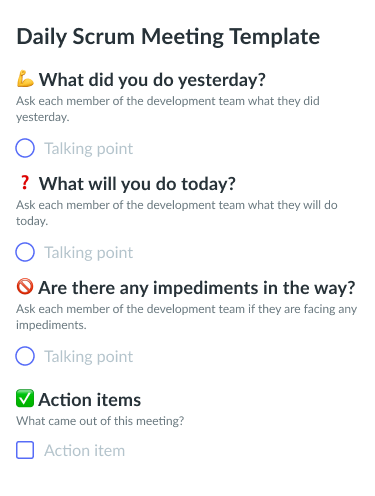
The most productive way to Scrum
As short as Scrum meetings are, they can be key to keeping your team in sync for just about any project. As you build out your team’s workflows, hosting daily Scrum meetings can help the entire process run smoothly.
Fellow has tools for all things meetings, including collaborative meeting agendas, meeting action items, and peer feedback. With Fellow, you can make 15 minutes of Scrum just as powerful as the rest of your team’s workday.

![[2024] Best Daily Scrum Tools & Software](https://fellow.app/wp-content/uploads/2023/03/scrum-meeting-software2.jpg)








